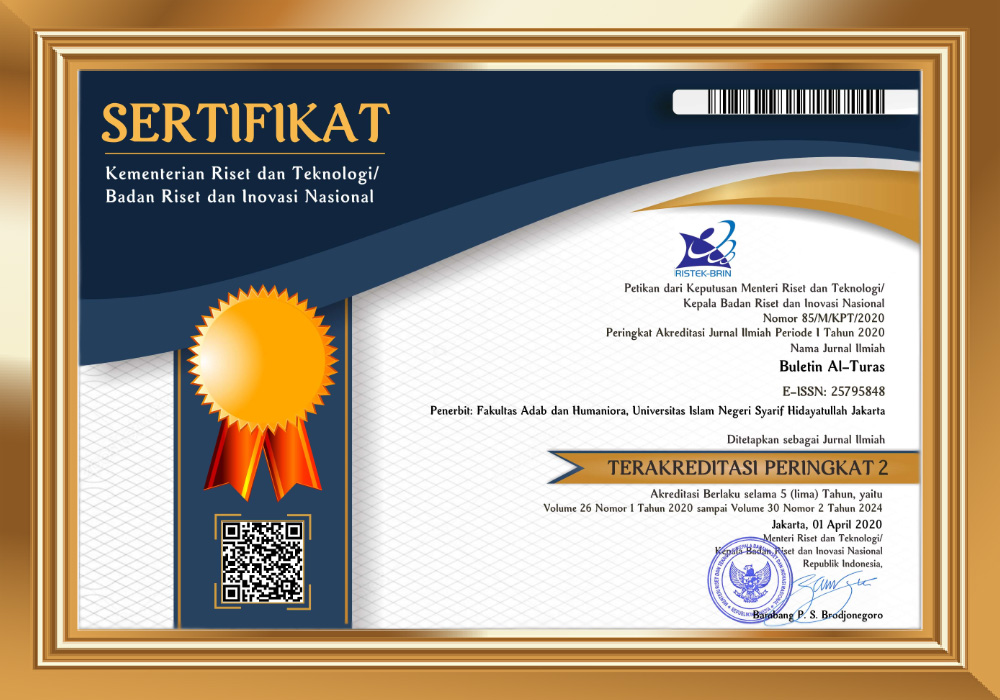The Depiction of Putin’s Power and Dominance in Political Cartoons about Russia-Ukraine War
Abstract
Purpose
This study aimed to investigate the depiction of Vladimir Putin’s Power and Dominance in political cartoons collected from usnews.com, and identified the social contexts underlying the creation of those political cartoons.
Method
This research used qualitative methods which engaged in discovering and uncovering the meaning of a particular phenomenon. The sample data was three political cartoons related to the Russia-Ukraine War taken from usnews.com. It employed Multimodal Discourse Analysis (MDA) approach of Visual Grammar from Kress & Leeuwen (2006) to examine the visual mode, and Systemic Functional Grammar theory from Halliday & Matthiessen (2014) to analyze the verbal modes.
Results/findings
The findings showed that Vladimir Putin in political cartoons was represented as a negative powerful figure through the dominant use of the narrative process. Whilst the images of Putin as a ruthless and dictator figure were revealed in the verbal modes through the use of material, relational, and mental process. Each political cartoon's social context connects the visual and verbal modes while providing clearer information about the reason for cartoonists created these political cartoons. The partiality of the American cartoonists to the United States and Western countries also revealed through the political cartoons that worked as a medium to convey the cartoonists’ thoughts, showing that they fought against the invasion.
Conclusion
Through visual and verbal analysis, the cartoonist constructed a negative portrayal of Vladimir Putin as a dictatorial leader. However, this study has limitations in its scope since it does not deeply address potential variations in viewer or audience’s interpretation based on individual backgrounds and experiences. Therefore, future researchers are encouraged to expand upon this study by exploring the production and consumption of similar texts, which may offer diverse or multiple perspectives on the subject.
Keywords
References
Ali, O. E. (2021). Visual Analysis: Representational and Interactive Meanings in The Remarried Empress. Transcultural Journal of Humanities and Social Sciences, 2(3), 15–37. https://doi.org/10.21608/tjhss.2021.206446
Al-Momani, K., Badarneh, M., & Migdadi, F. (2017). A semiotic analysis of political cartoons in Jordan in light of the Arab Spring. HUMOR, 30(1), 63–95. https://doi.org/10.1515/humor-2016-0033
Bevan, R. (n.d.). The lives of Hitler and Stalin: Two sides of the same coin. Sky HISTORY TV Channel. Retrieved 3 May 2023, from https://www.history.co.uk/articles/the-lives-of-hitler-and-stalin-two-sides-of-the-same-coin
Cavna, M. (2022, March 21). A Ukrainian artist left his home amid the war—But is still drawing cartoons taking on Putin. Washington Post. https://www.washingtonpost.com/comics/2022/03/19/vladimir-kazanevsky-cartoons-ukraine-putin/
Cleanse. (2023). In Merriam-Webster Dictionary. https://www.merriam-webster.com/dictionary/cleanse
Club. (n.d.). In Oxford Advanced Learner’s Dictionary. Retrieved 3 May 2023, from https://www.oxfordlearnersdictionaries.com/definition/english/club_1?q=club
El Refaie, E. (2009). Multiliteracies: How readers interpret political cartoons. Visual Communication, 8(2), 181–205. https://doi.org/10.1177/1470357209102113
El-Falaky, M. S. (2019). Caricaturing Two Revolutions: Multimodal Discourse Analysis of Egyptian Political Cartoons. International Conference on Education, Social Sciences and Humanities, 16.
Felicia, O. (2021). A social semiotic analysis of gender power in Nigeria’s newspaper political cartoons. Social Semiotics, 31(2), 266–281. https://doi.org/10.1080/10350330.2019.1627749
Forsell, L. M., & Åström, J. A. (2012). Meanings of Hugging: From Greeting Behavior to Touching Implications. Comprehensive Psychology, 1, 02.17.21.CP.1.13. https://doi.org/10.2466/02.17.21.CP.1.13
Game. (n.d.). In Oxford Advanced Learner’s Dictionary. Retrieved 3 May 2023, from https://www.oxfordlearnersdictionaries.com/definition/english/game_1?q=game
Given, L. M. (2008). The SAGE Encyclopedia of Qualitative Research Methods. SAGE Publications.
Halliday, M. A. K., & Matthiessen, C. M. I. M. (2014). Halliday’s Introduction to Functional Grammar (4th ed.). Routledge.
Horsey, D. (2022, February 18). Putin’s dangerous mind games. The Seattle Times. https://www.seattletimes.com/opinion/putins-dangerous-mind-games/
How Russia uses sarcasm as weapon in Ukraine crisis. (2022, February 16). AP NEWS. https://apnews.com/article/russia-ukraine-europe-russia-vladimir-putin-moscow-c7077c51178b52a32b0bb8740dffc1c1
Hussein, I. (2019). Analyzing Political Cartoons in Arabic Language Media after Trump’s Jerusalem Move: A Multimodal Discourse Perspective. 13(4), 451–465. https://doi.org/10.5281/zenodo.2643917
Knieper, T. (2018, February 20). Political cartoon. Encyclopedia Britannica. https://www.britannica.com/topic/political-cartoon
Kress, G., & van Leeuwen, T. (2006). Reading Images: The Grammar of Visual Design (2nd ed.). Rouletdge.
Mucchetti, A. (2022, April 11). Ohio State alumnus reflects on Russia-Ukraine war with political cartoons. The Lantern. https://www.thelantern.com/2022/04/ohio-state-alumnus-reflects-on-russia-ukraine-war-with-political-cartoons/
Musumeci, R. C., Natalie. (2022, March 17). Putin says Russia must undergo a ‘self-cleansing of society’ to purge ‘bastards and traitors’ as thousands flee the country. Business Insider. https://www.businessinsider.com/putin-says-russia-must-undergo-self-cleansing-society-2022-3
Oechsler, V., & Borba, M. C. (2020). Mathematical videos, social semiotics and the changing classroom. ZDM, 52(5), 989–1001. https://doi.org/10.1007/s11858-020-01131-3
Oktarianisa, S. (2022, February 25). Kronologi & Penyebab Mengapa Rusia Menyerang Ukraina. CNBC Indonesia. https://www.cnbcindonesia.com/news/20220225052726-4-318218/kronologi-penyebab-mengapa-rusia-menyerang-ukraina
Pflaeging, J., & Stöckl, H. (2021). The rhetoric of multimodal communication. Visual Communication, 20(3), 319–326. https://doi.org/10.1177/14703572211010200 Putin and the ‘self-cleansing’ speech which has seen him compared to Hitler: Traitors must be spat out like mosquitos from the mouth. (2022, March 18). MARCA. https://www.marca.com/en/lifestyle/world-news/2022/03/18/623476d5e2704eb94d8b45a0.html
Roth, A. (2022, February 16). Russians ridicule western media on ‘day of no invasion’. The Guardian. https://www.theguardian.com/world/2022/feb/16/russians-ridicule-western-media-on-day-of-no-invasion ‘Scum and traitors’: Vladimir
Putin threatens anti-war Russians. (2022, March 17). Aljazeera. https://www.aljazeera.com/news/2022/3/17/scum-and-traitors-vladimir-putin-threatens-anti-war-russians
Semotiuk, O. (2019). Russian-Ukrainian Military Conflict in American, German and Ukrainian Political Cartoons: Quantitative and Qualitative Analysis. Вісник Львівського Університету. Серія Журналістика, 45, Article 45. https://doi.org/10.30970/vjo.2019.45.10010
Sommer, V. (2021). Multimodal Analysis in Qualitative Research: Extending Grounded Theory Through the Lens of Social Semiotics. Qualitative Inquiry, 27(8–9), 1102–1113. https://doi.org/10.1177/1077800420978746
Threat. (n.d.). In Oxford Advanced Learner’s Dictionary. Retrieved 3 May 2023, from https://www.oxfordlearnersdictionaries.com/definition/english/threat?q=threat
Varaki, M. (2022, February 28). How has Russia violated international law? | Feature from King’s College London. https://www.kcl.ac.uk/how-has-russia-violated-international-law
Wardini, U. S. (2020). Visual and verbal sign analysis of Donald Trump’s political cartoon satire: Semiotics and multimodal analysis. [Undergraduate, UIN Sunan Ampel Surabaya]. http://digilib.uinsa.ac.id/44445/
Yang, J., & Zhang, Y. (2014). Representation Meaning of Multimodal Discourse—A Case Study of English Editorials in The Economist. Theory and Practice in Language Studies, 4. https://doi.org/10.4304/tpls.4.12.2564-2575
Zhabotynska, S., & Ryzhova, O. (2022). Ukraine and the West in pro-Russia Chinese media: A methodology for the analysis of multimodal political narratives. Cognition, Communication, Discourse, 24, Article 24. https://doi.org/10.26565/2218-2926-2022-24-09
DOI: 10.15408/bat.v31i1.37563
Refbacks
- There are currently no refbacks.
Copyright (c) 2025 Nurina Nasira, Alfi Syahriyani

This work is licensed under a Creative Commons Attribution-ShareAlike 4.0 International License.






